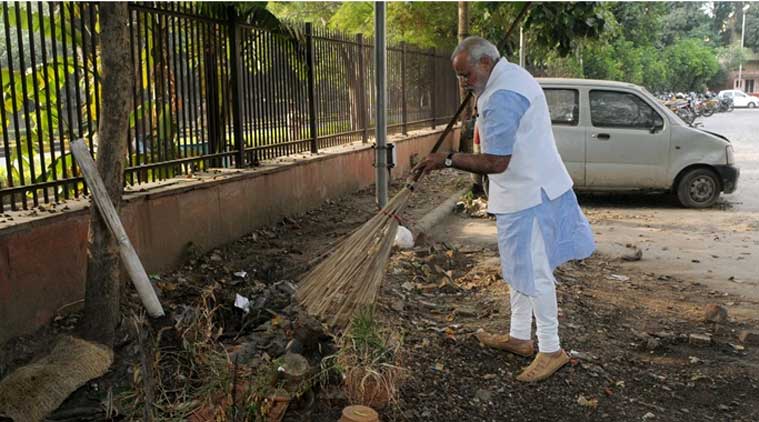- India
- International
Not a clean sweep
The Swachh Bharat guidelines make no mention of the new budget, so whether government expenditure will reach these levels is unclear.
 The prime minister has motivated citizens, activists, and researchers throughout India to turn their attention to eliminating open defecation.
The prime minister has motivated citizens, activists, and researchers throughout India to turn their attention to eliminating open defecation.
The stated goal of the Swachh Bharat Mission is to eliminate open defecation by 2019. But, from the guidelines released last month, it is clear that the mission will fail to reach its goal. There are at least two reasons for this: it wrongly focuses on construction and it does not present an effective strategy to solve the real problem, promoting latrine use.
When the Swachh Bharat Mission was launched in October, it was announced that it would have a budget of Rs 1,34,000 crore, over five years, to build a toilet for every house which doesn’t have one. On a yearly basis, this is nine times the 2013-14 Nirmal Bharat Abhiyan budget and amounts to roughly 2 per cent of the total Union budget for 2013-14. The guidelines make no mention of the new budget, so whether government expenditure will reach these levels is unclear. What we do know, however, is that this would be spending money on the wrong problem: lack of infrastructure does not seem to be why so many Indians defecate in the open. My colleagues and I recently conducted a study across Bihar, Haryana, Madhya Pradesh, Rajasthan and Uttar Pradesh, home to 45 per cent of households without a toilet. It revealed that most respondents who live in households with government-constructed latrines still defecate in the open. Building more of these toilets would be a waste unless the government simultaneously addressed people’s preference for open defecation.
Why do so many rural households prefer not to use government latrines? Many people believe that the pits of these latrines will fill up in a few months, when, in fact, if they are used by a family of six every day, it would take five to six years. Emptying a latrine pit poses particular challenges in India. Unfortunately, it is associated with “social pollution”, which means that the laws of supply and demand do not apply to pit emptying in the same way they might to other services. Only people from the lowest caste would empty a pit, and even they understandably seek to distance themselves from such work, a symbol of their past and continuing oppression. Therefore, there are important cultural reasons why so many Indians defecate in the open.
One way to address this issue could be through a sustained behaviour-change campaign. It is commendable that the guidelines call for a village-level “sanitation sena”, a term that may have been picked up from The Indian Express article written by my colleagues, Payal Hathi and Aashish Gupta. But they appear to have missed the main proposal that Hathi and Gupta were making: dedicated staff for promoting latrine use, working on nothing else but convincing people to use latrines. Instead, the guidelines suggest that village-level health workers could fulfil this role. This is a bad idea for at least two reasons.
First, these health workers already have a set of responsibilities. Piling on additional duties, particularly those that provide negligible compensation for hard work, will probably not help us achieve our goal. Second, as I have experienced on my visits to villages, many of these workers themselves don’t own or use latrines. So how can we expect people who defecate in the open to effectively convince others to use latrines?

One noteworthy addition to the Swachh Bharat Mission is the creation of a monitoring and evaluation cell. In a shift from the past, the policy calls for monitoring latrine use in addition to construction. The guidelines note that a third-party independent group will conduct an annual survey. The 69th round of the NSS has already measured latrine use, not just latrine ownership, and one promising development is that this might continue in future surveys. This step is necessary, although not nearly enough, for ending open defecation in five years.
The prime minister has motivated citizens, activists, and researchers throughout India to turn their attention to eliminating open defecation. But now that the mission guidelines have settled for the mere semblance of an action plan, what should those of us committed to solving the problem do?
A dismal answer would be to wait: the third-party monitoring system could be used to hold the government accountable in a few years’ time. But open defecation kills too many children for that to be a complete answer. Another possibility is to learn more about the cultural forces related to notions of caste, purity and pollution, and to work out how they might be fought. We could also encourage the states, responsible for implementing the mission, to build on it, making it their own and creatively adding what is needed to make it successful. This is a tall order, and only some states may be up to the task, but we should all keep up the pressure.
The writer is associate director at the Research Institute for Compassionate Economics, Delhi
EXPRESS OPINION
More Explained
Apr 26: Latest News
- 01
- 02
- 03
- 04
- 05











































